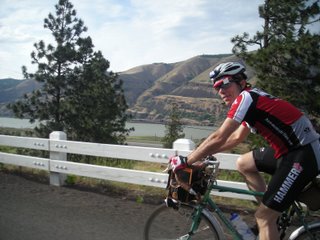
Today I have a great interview with author, David Rowe. I recently reviewed his new long distance cycling book, The Ride of Your Life.
I asked readers for long distance cycling questions for David. There was a great response so there were a lot of questions for David. I gave him the option of skipping some of them but he took the time to answer all of them.
5 readers that asked questions get a free copy of David’s eBook, The Ride of Your Life. With so many good questions, it was tough to pick the eBook winners. Congratulations to the following
David is a road bike rider who lives, works and rides in the Pacific Northwest.
His goal-centered approach helped him break the 100-mile-barrier and attempt routes in the remote Cascade Range and Columbia Plateau with cyclists called randonneurs. What he learned while riding with these highly skilled cyclists helped him complete some of the most challenging road biking events in the Northwest, including the Cascade 1200, the Portland-to-Glacier 1000, and the Rocky Mountain 1200.
With his son Evan, David created Ready to Ride® in 2005 with the goal of helping cyclists who, like himself, do not have a background in road racing, but want to excel at long distance riding. Ready To Ride® is a Web site for sport-recreational cyclists who want to balance the demands of career and family with the physical, mental, and equipment demands of long distance cycling.
UltraRob: How did you get into cycling initially?
David Rowe: I was going to school at UC San Diego in La Jolla, and living about 10 miles north in Cardiff by the Sea. I was looking for cheap transportation to school. One of my buddies sold me his rusted-out Peugeot. I had it sand blasted, and my Dad and I repainted it in the garage. I joined the bicycle co-op at school and built it up one part at a time. It was a great bike, very light, and very fast. I rode it to school every day, and I was blown away by my fitness. I was into competitive surfing at that time, and I noticed that my improved leg-strength was allowing me to carve much more aggressive turns in the wave. So I began to use cycling as cross-training for surfing. Cycling really got to be a part of my life from that point on. I guess it’s been more than 30 years now since I built that first bike. I’m still wrenching and riding!
UltraRob: Did you one day decide you wanted to ride a 1200k brevet or was it a slow progression of doing longer and longer events?
David: Riding the Cascade 1200 was a huge leap for me. I didn’t even know it was a randonneur event! I did what randonneurs recommend you don’t do, which is to ride your first Super Randonneur series (200K, 300K, 400K, 600K) and ride a 1200K during your first season in the sport.
But my confidence was way up, having just completed the Torture 10,000 (in the Oregon Cascade Range), but I really did not understand the difficulty of that ride when I sent in my deposit. I was 49 years old and wanted to plant a significant marker in my life during my 50th year. I was scouring the Internet for big rides and found it, right in my own back yard.
UltraRob: What has been your most enjoyable event and why?
David: Last year, I rode a 600K brevet in Washington called Four Passes. It was an epic ride. We rode out of Seattle in pouring rain, climbed through snow-covered roads on Stevens Pass. Mt. Rainier is one of the most dramatic rain shadows in the world, and the set-up was working perfectly. As we descended into Leavenworth, the sun broke out, we tore off our rain gear and enjoyed a warm, sunny day in dry, central Washington before heading back into the Cascade Range. By the time we were back in the Cascades, the rain-storm had moved out and we had clear skies and stars. We rode on two more passes on the way to the overnight control, which was just below White Pass. We got up to the lodge about 11:30pm, ate a big dinner, got a few hours of sleep, and were back on the road at 4:30am. We had to climb the rest of White and then Cayuse Pass to get to them, but wow – the descents were incredible. The final one into the Greenwater control was 30-plus miles!
UltraRob: Do you do long events because you enjoy riding, the sense of accomplishment when you complete a goal or do you enjoy suffering?
David: Looking back on what I’ve done are the proof-points, but not the rewards. I stopped buying the medals for all but the big events. I don’t keep my numbers, or the brevet cards.
Cycling is one of the few areas of my life where I can really live in the moment. When I am riding a brevet, I can truly shut-out the rest of the world. It’s the closest thing I can think of to the feeling you had as a child, when you were totally absorbed in play. There was nothing else – only that which you were experiencing – real or imagined.
I’m not big into suffering, though there’s plenty of it out there on the road. I’ve done what I can to marginalize it with my training regimen. But my weak points – Achilles tendons, knees, low back – eventually start talking to me. I gauge how much pain I’m in based on when I have to start taking 800mg Advil tabs. I don’t like to take them, because once you do, you can’t feel the pain so much, and that’s when you are likely to do the most damage.
There is a benefit to the suffering, though. When things get tough for me at work, or in my personal life, I compare it to the level of stress or anxiety or pain that I might have felt on a ride like the Rocky Mountain and Cascade 1200s, and nothing can hold a candle to it. Thinking about a problem in that light gives me the confidence that I can handle it.
UltraRob: In your book, you focus on the mental part of long distance cycling. Do you feel the mental part is harder than the physical?
David: They are closely related, maybe inversely related. The greater level of fitness you attain, the less likely you are to encounter repetitive motion injuries, so you may not have to call on your mental powers to stay in the ride.
The problem most riders encounter, though, is mustering the motivation in a long training period, to adequately prepare for an event. You can take 10 weeks and be fit enough to handle a century. Getting ready for an ultra cycling event like a 1200K requires 26-weeks. If you’re training for an event in June or July, that means you are going to be getting to know your trainer, and most riders hate that. Or they hate the gym and won’t get in to do the core training.
In my book, I try to help riders load their goals with deep emotional pay-offs, so they literally pull them out of bed in the morning to train, when they’d rather be sleeping in. The process I share will also help you work through the opportunity cost in advance of the training, so riders can opt-out of a ride that sounds cool on the surface, but really isn’t a good fit with their life at the time.
UltraRob: There are the weekend
warriors that do most of their riding on the weekends. Do you think this is a smart way to train for a long distance event?
David: Distance riders have to get one long ride in on the weekend, sometimes, two, as the event draws near. But doing long rides without riding during the week is a recipe for failure. You’ll either injure yourself on the weekend, or at the event. I talked about a real-life weekend warrior in the book. He let me look at his training program. It was hard to see the problem, at first, because he sent me his monthly mileage and hours, and they looked great. I asked him to send me the daily detail, and there it was: the shock and awe approach to training. 95 percent of this rider’s miles were on Saturday and Sunday. He started to get sick on rides, and eventually, he quit the sport.
UltraRob: I have friends that say they’re hurting at the end of a century. They think if they’re hurting a 100 miles into a ride it’ll just hurt more at 200k or a double century. If you’re hurting half way through a ride, do you find worse at the end or have you not found that to be the case?
David:I think most long distance riders will tell you that the bliss (the cyclists’ high) begins at 100 miles. But most riders also find they have a pain-point they have to ride through. I experience the greatest discomfort at about 50 miles. Rarely does it come after 100 miles. By then, I’ve got it all dialed – food, pace, clothing. Repetitive motion injuries are a wildcard; and most Achilles issues show up on the second day. But if your training includes stretching and strengthening ankles, knees, and your core, I think you can avoid most of that. Those kinds of exercise are the ones that riders struggle with; they can be boring. But they are the key to success in “the back nine,” if you know what I mean.
UltraRob: If you’ve dropped out of a long ride, which ride was it and what caused the DNF? If you haven’t dropped out, What is the closest you came to quitting but continued on?
David: I’ve never quit or DNF’d – knock wood. I suppose it’s out there for me, but I want to avoid it if I can. But I have to be honest, there is a point on every ride where I question my motives. I wonder why I’m doing it. Sometimes that still small voice isn’t so small.
It was screaming at me on the Cascade 1200. I’ve written about that at length on my site, Ready To Ride, so I won’t recap that saga here. But I think you might find it good reading.
Suffice it to say that if some very experienced randos hadn’t encouraged me to eat, and then asked me the questions they did, I might have quit the ride of my life. Finishing it – or not finishing it – either option was going to be a life-changing event. I decided to finish. I got into the final control just 60 seconds before the cut-off – 60 seconds to spare in a 90-hour ride. Thinking about how close that was gives me the shivers, even right now.
Mike B.: I’m curious how one trains for ultra-distance events. In particular how does one balance the training time with family time?
David: Answering that question was the primary reason I wrote The Ride of Your Life. All I can say is that it varies, from year to year. You really need to square-off with how important your family is to you. I think one of the reasons you see older riders in ultra distance events is that they have the time to devote to it – that and the fact they’re not able to do the crits and the stage races any more!
There are lots of ways to creatively get the training hours in, though. Get up early and ride before the family is awake. Commute to work on your bike. On long weekend rides, have your wife drive out and meet you at some point in the course for a picnic. That works really well for events, too. You can integrate a family vacation into the weekend.
UltraRob: Along with balancing family time, most people have jobs that take up a big part of week days. You’ve said WebMD is supportive of your riding, but I’m sure as vice president of marketing you don’t get a free ride. How do you manage it?
David: The big one for me is commuting to work on the bike. I am able to get 30 miles and 2000+ feet of climbing in each day. I can increase the miles or the altitude by leaving earlier. On some summer mornings, I’ll increase the ride-in to 50 miles. The only morning you’ll find me on the main arteries is when I need to make an early morning meeting. Otherwise, I treat my commute like training ride.
I also make a point to let my boss and my team know about my riding goals and my events. We are a health services company, and I’m responsible for consumer engagement. So the fact that I’m eating healthy foods and exercising is consistent with our vision and values. It also makes me sensitive to the difficulties of sustaining a healthy lifestyle, and I think that makes our engagement efforts more effective as a result.
Allen B.: Before we had kids, my wife and I did a fair bit of long riding and some together, some by myself. Since our first daughter arrived, I have had an increasing awareness of their physical, emotional, spiritual – not to mention, financial – dependence on me as their dad. It is one of the greatest privileges in my life, however this awareness has led me to scale back my cycling to “safe” trails and roads with well-marked bike lanes, especially in light of the death of a couple of road bikers in our community. And, my brother – a very safe biker – has been hit by cars twice in the last 18 months. How do you deal with the inherent risks involved with road/long-distance biking when a family with small children is depending on you?
David: I have looked at the statistics and more people are hit by cars walking on the streets of their neighborhoods than cyclists are hit riding.
With that said, I realize that riding a bike increases the risk of injury. I have taken some time to my financial house in order, just in case I cannot work, or worse. I have disability and life insurance, which I think all of us who provide for dependents should have, if we can afford it.
It’s also important that you do everything you can to be seen on the bike. I know that reflective vests and ankle bands and blinky lights aren’t cool on a Saturday morning club ride. Neither are fenders and 28mm tires. But these are things we can do to increase our personal safety and we’ve got a responsibility to ourselves and our loved ones to do use all of the geeky gear, even if it means we have to ride alone on Saturday morning!
Mike H. and Bob M.: What do you do to stay motivated during long-distance events (especially ones where you’re out there by yourself)?
David: First and foremost, you have to know why you are out there riding. I love the outdoors, so it’s a rare day that I’m not loving the feeling of riding. Even in the rain – with the proper gear – I’m loving it. Music helps me, a lot. I ride with an iPod; so do most of the guys I ride with. I think it’s safe to do so as long as you aren’t turning up the volume to the point you cannot hear cars approaching you from behind.
UltraRob: Ken H. has a somewhat similar question to the above but brings in how the physical affects the mental.
Ken H.: How do you battle both the mental exhaustion of kilometer after kilometer of repetition and stay focused, but also how to you stay mentally tough as the kilometers beat on your body. As fatigue increases I’m sure it only ge
ts tougher to stay motivated and focused.
David: The key is to chunk it down. On a brevet, you have controls. On an ultra, you have checkpoints. That’s where you focus – not on the entire ride. You just think about the next leg of the ride, and what’s in front of you.
You need to get your head up and look at the terrain. If the route will take me over a mountain pass, I try to make it out as far in advance as I can. If you are in the desert, you can see your route 30 or 50 miles up ahead if you’ve studied your maps. Then, you see the progress you’re making on the landscape and it’s a terrific feeling. I’m always amazed at how much ground you can cover on a bicycle. On a long ride, you will be shocked to keep seeing the same cars throughout the day, as they stop to fuel or eat, over and over again, while you just keep pedaling.
Ken H.: What methods do you employ to stay healthy and injury free? I’m sure the amount of cycling that you’re doing is doing a number on your body… Yoga? Regular massages? Just battle through the pain?
David: I have a physical therapist and during the season, I’m there two or three times a month. That’s been huge and has helped me to insure that my injuries heal without scar tissue. Long distance cycling has actually helped me to flush-out old injuries that didn’t heal right, and ‘fix them’ as a result of re-injury, then proper healing with physical therapy. But in the end, staying fit the year round is the key to riding with a minimum of injury. Nobody I know rides injury-free. This is an athletic pursuit and athletes manage injuries, they don’t avoid them.
Steve H.: What are your recommendations for leg issues, i.e. cramps, inflamation, etc.
David: Strengthening exercises are very helpful. So are stretches. Do these during the week, either at home or at the gym. I also recommend learning to stretch on the bike while riding. There are a number of yoga moves you can do while descending to stretch your lower back and your hamstrings while you’re descending. You can stretch your upper back while riding the flats. It’s good to make these habit, so when you get into the right terrain, you get automatic triggers to stretch.
Mike P. and Robb S.: For single day rides greater than 100 miles without a support vehicle, how do you either plan where you will stop for food (and how often) or how do you carry enough with you to keep the energy up. I just finished reading Ultramarathon Man and Dean eats 10,000+ calories during some of his 100 mile 1 day runs. While I’ve only managed a 55 mile ride last season, I have several planned century rides this year and keeping the energy / food levels up are one of my main concerns.
David: I am convinced that Hammer Nutrition has developed the ideal model and foods for long distance riding. It was a leap of faith for me to ‘put the Hammer down,’ but it works. On event days, I do not eat anything but Hammer fuels. I wrote a piece about that on Ready to Ride. It’s lightweight, and the proper mix of fuel, and electrolytes, keeps me from feeling hungry. The only time I bonk is if I fail to stay on my feeding schedule. It’s quite remarkable.
Another benefit of carrying your own fuel is you can minimize your off-the-bike time, which can be a killer. I ride a lot of brevets with Eric Ahlvin and John Kramer. All three of us are “on the Hammer.” It allows us to get into and out of a control in minutes. Other guys are getting in line at Subway or whatever and we’re riding away, putting serious gap on them. It’s a huge benefit if you can ride with others who use the same fuels.
UltraRob: Joel S. has a questions similar to the previous one but gets to how do you get the calories down.
Joel S.: I find that there’s no way I can consume enough calories while riding. What’s your strategy for eating and why?
David: According to the folks at Hammer, you can burn 600 to 800 calories an hour, but you can only ingest about 250 to 300. So that’s what they recommend you take in, in liquid form. The reason riders begin to feel queasy on long rides is they get too hungry, then gorge on a sandwich or whatnot, and it just sits there in the stomach. Liquid fuels got into the bloodstream in minutes. You can feel it happening. It’s borderline bizarre.
Steve H.: For long distances, do you prefer a true road ride or a MTB or touring or hyrid?
For unsupported brevets, I use a Titanium bike that’s been designed and built for this sport. It’s as light as it can be, but it’s also using parts that I can service on the road at my skill level, and with minimal tools on hand. In randonnuering you cannot accept any support accept at controls, and you’d be lucky to find tools at a control. So durability is critical, that’s why you will see Ultegra components and Mavic Open Pro rims on my rando machine.
In a supported race – like a UMCA event – I’ll be riding a Litespeed Tuscany with all the modern, lightweight parts. Of course, there’s a follow-van to help with repairs.
Lloyd L. and Steve H.: I’ve tried a lot of different types of saddles–spent a lot of money. What is your favorite saddle for long-distance events and why?
David: I have a few, but the most comfortable saddles I have are leather. The Brooks B-17, and the Selle Anatomica are fantastic. John Spurgeon (profiled in my book) rode RAAM on the later, and that convinced me to try it. It was as soft on my first ride as the B-17 was after a year.
Steve H.: Which is your favorite chamois cream?
David: I’m laughing … the stuff that’s really popular at the moment is something called Lantiseptic. It was developed for hospital patients, and others who must spend days on end in bed, and can develop rashes or worse. I began using it and I wouldn’t think of using anything else. You won’t find it at your LBS, or even at your drug store. You have to order onlne. It’s gotten so popular with randos that the company is advertising in American Randonneur!
UltraRob: Since most of your long distance rides have been in the Pacific Northwest, I’m guessing you’ve done much more riding in the rain than I have here in Colorado. What are some wet weather riding tips?
David: I wrote a series about staying dry in the rain on Ready to Ride. The most important one is about the rain jacket that I use. The other posts in the series are on feet and legs.
UltraRob: David, thanks for taking so much time to answer all the questions in this long interview. You’ve provided a lot of information for cyclist wanting to take on longer rides.
David has many more details are preparing mentally for your long distance cycling adventures in his book, The Ride of Your Life. If you want to find out more about the book before buying it, you can read a 34
page preview or read my review of it.

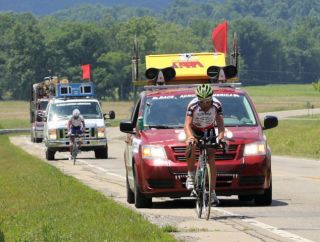
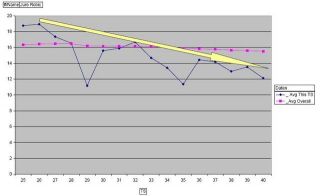
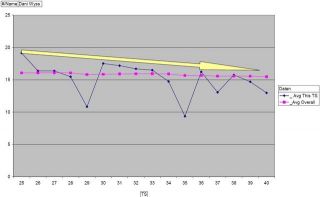




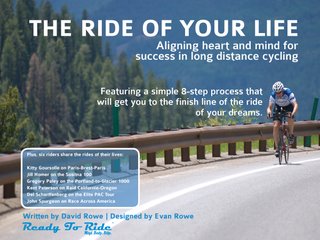
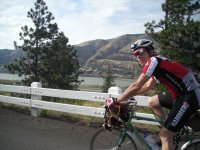
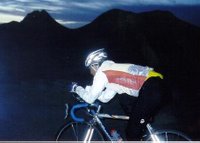
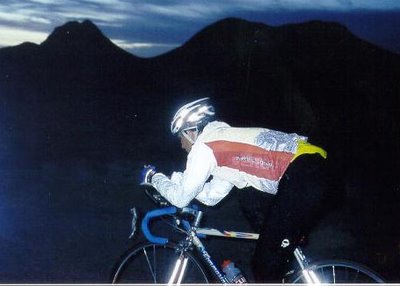
 Blog RSS Feed
Blog RSS Feed Like on Facebook
Like on Facebook Follow on Twitter
Follow on Twitter Flickr
Flickr Contact
Contact
